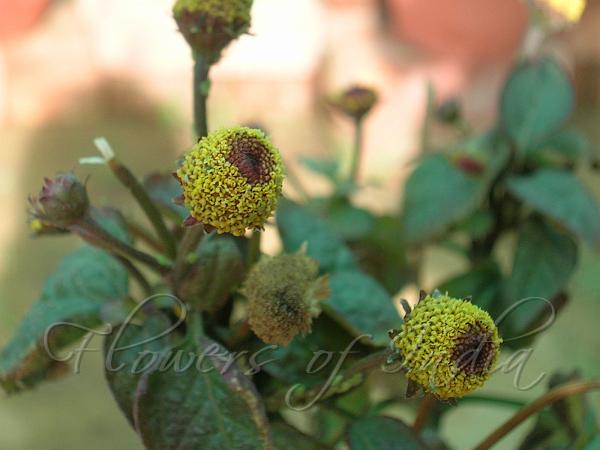|
| Toothache Plant |
|

|

| File size | 218427 |
| Original date | 2/18/06 4:00 PM |
| Resolution | 2048 x 1536 |
| Flash | Flash did not fire, auto |
| Focal length | 10.5mm |
| Exposure time | 1/83s |
| Aperture | 3.7 |
| Focus Distance | |
| Metering Mode | Partial |
| Camera make | NIKON |
| Camera model | E3700 |
| Sensor type |
|
|
|
|
Photo: |
Botanical name: Acmella oleracea Family: Asteraceae (Sunflower family)
Synonyms: Spilanthes acmella var. oleracea, Spilanthes fusca
Synonyms: Spilanthes acmella var. oleracea, Spilanthes fusca
Toothache Plant or "Paracress" is a flowering herb. Its
leaves and flower heads contain an analgesic agent that may be used to numb
toothaches. It is grown as an ornamental (and occasionally as a medicinal)
in various parts of the world. The stems are prostrate or erect,
often reddish, hairless. Leaves are broadly ovate to triangular, 5-11 cm long,
4-8 cm wide, margins toothed, tip sharp.
Flower-heads arise singly, elongated-conical, containing primarily disc
florets, 1-2.4 cm long, 1.1-1.7 cm in diameter. Disc florets are many, yellow
to orange, 2.7-3.3 mm long. Achenes are black, 2-2.5 mm long.
Eating Toothache Plant is a memorable experience. The leaf
has a smell similar to any green leafy vegetable. The taste, however, is
somewhat reminiscent of Echinacea, but lacking the bitter and sometimes
nauseating element of that medicinal. First, a strong, spicy warmth spreads
outward across one's tongue, turning into a prickling sensation. With this
the salivary glands leap into action, pumping out quantities of saliva. As
the prickling spreads, it mellows into an acidic (slightly metallic)
sharpness accompanied by tingling, and then numbness. The numbness fades
after a time (two to twenty minutes, depending on the person and amount
eaten), and the pungent aftertaste may linger for an hour or more.
Medicinal uses: The leaves and flower heads contain analgesic,
antifungal, anthelminthic, and antibacterial agents, but some of the
compounds are destroyed by desiccation or freezing.
The leaves and flower heads contain analgesic,
antifungal, anthelminthic, and antibacterial agents, but some of the
compounds are destroyed by desiccation or freezing.
Medicinal uses:
 The leaves and flower heads contain analgesic,
antifungal, anthelminthic, and antibacterial agents, but some of the
compounds are destroyed by desiccation or freezing.
The leaves and flower heads contain analgesic,
antifungal, anthelminthic, and antibacterial agents, but some of the
compounds are destroyed by desiccation or freezing.| Identification credit: Akramul Hoque, Shaista Ahmad | Photographed in cultivation in Delhi & Himachal Pradesh. |
• Is this flower misidentified? If yes,